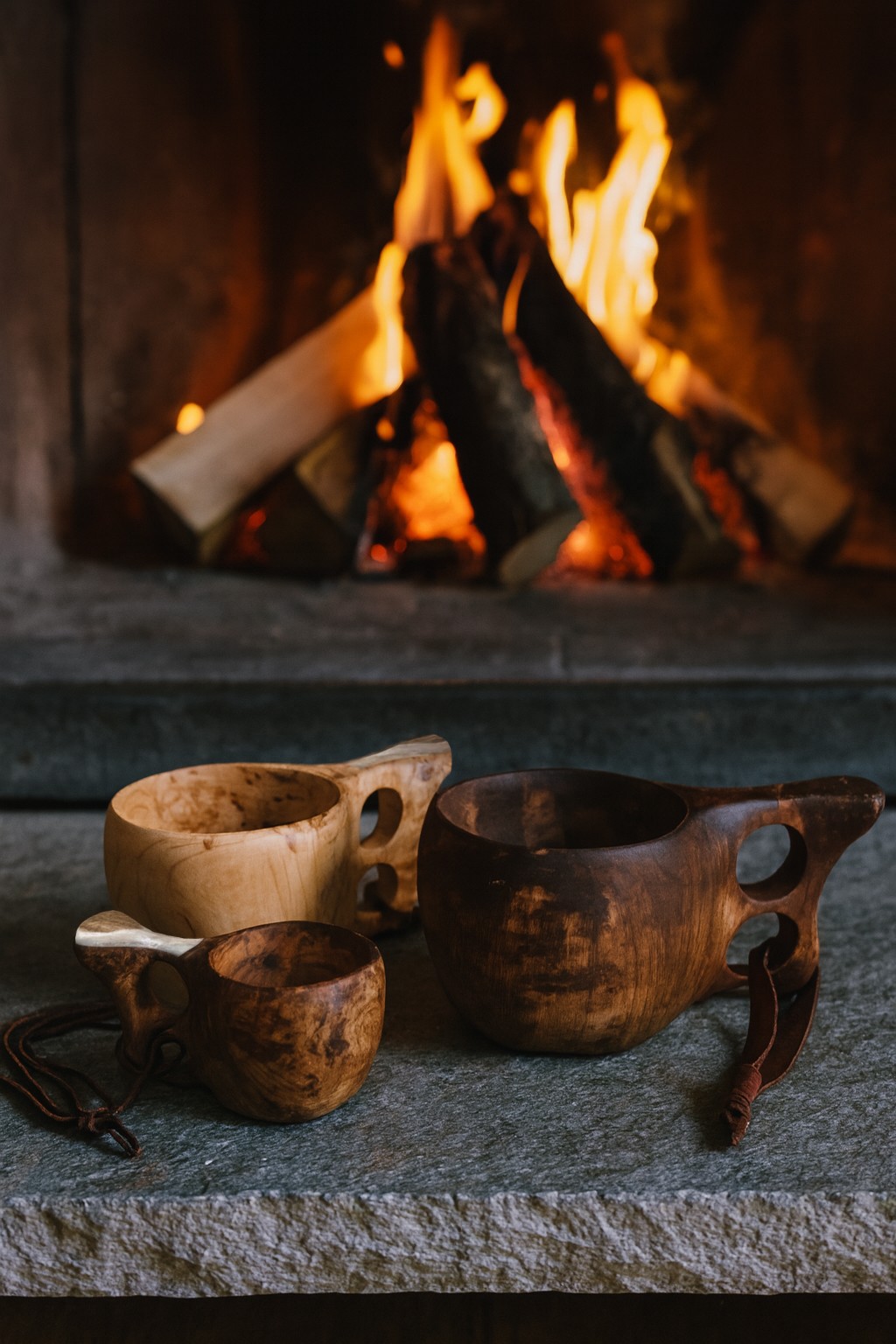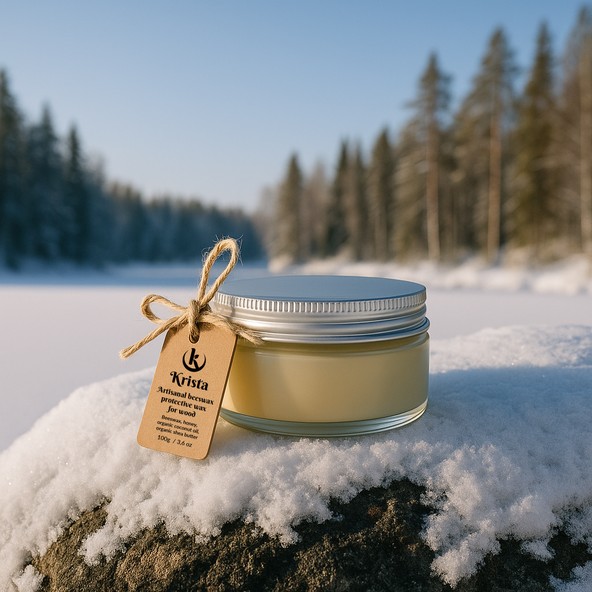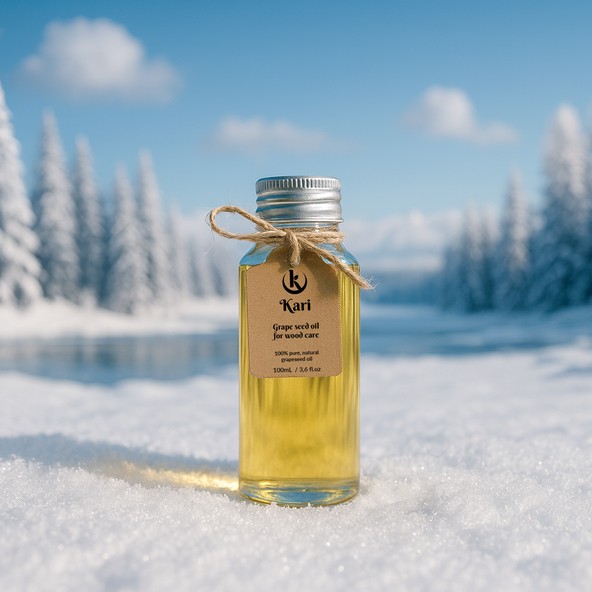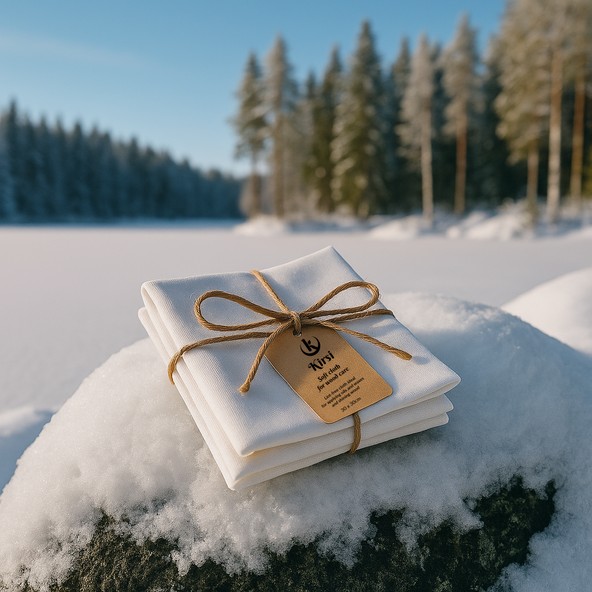A handmade Christmas elf is gifted with every order 🎄🎁 A handmade Christmas elf is gifted with every order 🎄🎁
Our natural tips for caring for your wooden tableware
Wooden tableware is a beautiful alternative to plastic and ceramic. It adds a natural, authentic touch and warmth to a table. But it's also tableware that's more complicated to care for. Wooden tableware requires regular maintenance so the wood retains its strength and beauty and stands the test of time.
Throughout this article, we'll guide you so that you can properly clean, protect and store your wooden tableware.

Anne-Laure Compain
When you decide to use wooden tableware, it's not just an aesthetic choice, it's also a sustainable and environmentally-friendly one.
Enjoying your meals with handmade wooden tableware means knowing that wood is a living material that needs to be cared for and maintained. Unlike porcelain or plastic tableware, wooden tableware will react to humidity, heat and chemicals.
Wood is solid, but not unbreakable. Over time, it will become imperfect, scratched, warped or change color. But that's the charm and authenticity of wooden tableware.



What happens if you don't take care of your wooden tableware?

Humidity
Wood is a material that can absorb moisture and water. This is a problem for wooden tableware because when exposed to moisture or liquid for too long, it can swell, warp or even crack.

Thermal shocks
When wood suddenly goes from room temperature to hot or cold, it reacts noticeably. Because of this temperature shock, your wooden tableware may warp or, more seriously, crack.

Scratches and wear
Wood is a softer material than plastic or porcelain, so it is more sensitive to scratches and knocks, which will weaken tableware. For example, non-wooden cutlery will damage and scratch wooden tableware.

Preserving beauty
Regular use of wooden tableware will give it small imperfections. To preserve its natural beauty, you need to maintain it regularly with suitable, non-chemical products.
How to clean wooden tableware naturally?
The most important points of this article:
- Do not put wooden tableware in the dishwasher.
- Wooden tableware should not be washed in boiling water.
- Wooden tableware must not be soaked in water.
- Wooden tableware should not be washed with conventional washing-up liquid.
- Do not use abrasive sponges to clean wooden tableware.
Now that the most important points have been covered, I'm going to go into a bit more detail.
When wood is in contact with water for too long, it becomes brittle. When washing your tableware, be careful not to leave it to soak in water, otherwise the wood may become stained or warped. Secondly, you need to use lukewarm water to wash your tableware, as boiling water causes cracking and warping.
As far as the dishwasher is concerned, it brings together everything that wooden tableware doesn't like: high heat, humidity and boiling water. So, if you want to keep your wooden tableware as long as possible, keep it out of the dishwasher! So, how do you wash your wooden tableware?
Hand washing
To make cleaning easier, it should be done after each use of the dishes. If you leave food to dry on the wood, it will be more difficult to remove.
- Wash dishes by hand using lukewarm water and mild soap or a 100% natural organic (acid-free) dishwashing detergent.
- Use a soft, non-abrasive sponge to wash your dishes. Don't rub your dishes too hard with your sponge, or you'll scratch them.
- After your dishes have been washed, rinse them to remove any soap residue. Be careful not to soak your dishes in water.
- Dry your wooden tableware immediately with a clean, soft, dry cloth. Immediate drying allows the wood to absorb as little moisture as possible.
It's important to know that no matter what cleaning technique you choose, once washed and dried, your wooden tableware will have a duller, whitish color. This is normal! Simply apply oil or beeswax to restore the wood's beautiful color.
Choosing a gentle soap
In this section, I'm going to tell you about a particular soap that I make by hand in our workshop. It is specially designed to gently and naturally clean wooden tableware and our kuksa.
What is this soap made of?
Our soap is made without soap! That means it was not produced by a chemical reaction called saponification. So how is it made? Quite simply by mixing organic sweet almond oil, Finnish honey, mineral water and coconut.
Why use our almond-and-honey soap for your wooden tableware?
- It's a gentle, non-abrasive soap that will clean the surface of the wood without damaging it.
- The honey in the soap creates a very thin protective layer on the surface of the wood, similar to what beeswax might do but less effectively.
- Honey will also eliminate bacteria on the surface of the tableware thanks to its natural antimicrobial properties
- Sweet almond oil is a highly nourishing and moisturizing oil that brings out the natural beauty of the wood.
How to use our soap?
This soap lathers very lightly, but it's enough to wash your wooden tableware. To do this, moisten the soap with lukewarm water, then wash your dishes. Then rinse and dry immediately with a dry cloth.
🌳 Cleaning example: a kuksa used to drink coffee
- Left photo: before cleaning
- Right photo: after cleaning and drying
You'll notice that the traces of coffee and salt have disappeared. The kuksa is a little whiter but that's normal when it comes into contact with water. Once oiled, it will be like new! I'll show you the oiled result a little more below.


Discover the kuksa care video using our almond and honey soap ⬇️
Choosing black soap
Like the gentle almond oil and honey soap, the black soap spray I'm talking about is made in our workshop.
It's made from a blend of :
- Black soap
- Black soap is 100% natural. It's a mild soap that removes dirt, food residues and grease from wooden tableware.
- Linseed oil
- Linseed oil will moisturize, nourish and protect wood.
- Demineralized water
- We use demineralized water because it contains no minerals and therefore won't stain the wood or leave rings.
This spray is perfect for cleaning your dishes naturally. Simply spray on the dishes and wipe off with a clean, dry, lint-free cloth.
🌳 Cleaning example: a kuksa used to drink coffee
- Left photo: before cleaning
- Right photo: after cleaning and drying
This wooden mug has been soiled with coffee just as it was when cleaned with mild soap. The end result is the same: the mug is clean, smells good and the wood is undamaged.


Watch a video on how to care for a kuksa with our black soap spray ⬇️
Choosing organic washing-up liquid
Conventional dishwashing liquids should not be used to wash wooden tableware. They contain very powerful and chemical cleaning agents, artificial fragrances, colorants and foaming agents. In short, everything you don't want on wooden tableware.
Why is organic washing-up liquid better?
- They are generally gentler and less aggressive. They will therefore damage wood less, dry it out less and whiten it less.
- They contain no chemicals, colorants or artificial fragrances.
- They are made from natural, renewable and biodegradable ingredients. So they're good for our planet.
- The fragrances found in organic washing-up liquids are often essential oil-based or fragrance-free.
🌳 Cleaning example: a kuksa used to drink coffee
- Left photo: before cleaning
- Right photo: after cleaning and drying
The washing-up liquid washed the cup very well but, despite being organic and chemical-free, it bleached the wood a lot (more than other cleaning techniques).


Discover the care video for a kuksa using organic, natural and fragrance-free dishwashing liquid. ⬇️
Choosing white vinegar
White vinegar is a good natural and economical choice for cleaning and disinfecting your wooden tableware. However, it should be used sparingly and always diluted with water, as it is highly acidic and can damage wood if used undiluted.
Why use white vinegar on wooden tableware?
- 100% natural
- 100% edible
- Degreases wood surfaces, practical for cutting boards, plates or utensils
- Disinfects and removes bacteria and mildew from wooden tableware. White vinegar has antibacterial and antifungal properties.
- Eliminates odours that have permeated wooden tableware.
How to use white vinegar on wooden tableware?
- Dilute 1 part white vinegar to 5 parts water.
- Apply this mixture with a cloth or non-abrasive sponge.
- Leave to act, then rinse and dry immediately.
White vinegar is ideal for cleaning wooden utensils and cutlery, removing all grease and food residues.
However, vinegar may leave a slight odour on the wood, so rinse it well.
🌳 Cleaning example: a kuksa used to drink coffee
- Left photo: before cleaning
- Right photo: after cleaning and drying
As you'll see in the video, the white vinegar doesn't remove all the stains. The coffee stain on the front of the cup doesn't come out completely, even if I insist on using my sponge.It's a very good disinfectant, but not a good cleaner.


Watch the video on how to maintain a kuksa with white vinegar. ⬇️
Discover the incredible versatility of wood through various species and the world of woodworking. By subscribing, you'll receive information on wood and wood species once a week.
How to dry wooden tableware?
Knowing how to dry your wooden tableware is half the battle in keeping them in good condition. That's right! Drying wood is very important, and helps prevent it from warping, cracking or going mouldy. So I will explain how to dry your tableware properly.
How to dry your wooden tableware:
- After washing your wooden tableware, you should immediately dry it with a clean, dry cloth to prevent the wood from absorbing moisture.
- Use a clean cotton cloth for drying, as cotton will absorb moisture from the surface of the wooden tableware.
What not to do:
- Do not leave your wooden tableware to dry in the open air, as this encourages mildew, cracking and warping. The wood will absorb too much moisture and degrade.
- Do not use a damp or dirty cloth to dry your tableware. Nor should you use a rough cloth, as this will damage the surface of the wood.
What good practices should you adopt to properly store your wooden tableware?
If you know how to clean and care for your tableware but store it the wrong way, all your efforts will be in vain. It is just as important to know how to care for your wooden tableware as to know how to dry or store it.
Avoid sources of humidity
As I have written on several occasions, humidity is wood's worst enemy — both during cleaning and storage. To prevent moisture from affecting your wooden tableware, store it in a dry, well-ventilated place. Keep it away from your sink, windows, or kettle.
You can also use silica sachets and place them with your wooden tableware. Silica sachets are filled with small granules of silicon dioxide, a powerful desiccant with strong moisture-absorbing properties. They're the little sachets found in shoeboxes or some packaging.
Avoid areas of high heat
Wood doesn't like temperature variations and shocks. You should therefore avoid storing your wooden tableware in areas where the temperature will fluctuate, such as a cupboard next to an oven or a hob.
Appropriate storage
Wood can be scratched or scuffed if it is stored improperly. Take care not to let your wooden tableware come into contact with metal or steel utensils. You can also add a sheet of felt to the bottom of your drawer or on your shelf to protect the underside of your tableware. Another tip is to use hooks and hang your wooden tableware.



Things to remember when storing your wooden tableware:
- Store your wooden tableware in a dry, well-ventilated place.
- If possible, use hooks or open shelving units to store your wooden tableware.
- Don't always use the same cutlery, plate, or cup. Rotate your items so you don't wear out one more than the others.
What natural products can I use to care for my wooden tableware?
There are several products available to care for your wooden tableware in a 100% natural way. I've tested 5 different products for you, showing you the before-and-after and explaining how to use them. After presenting these 5 products, I'll tell you which one is best for wooden tableware.
Beeswax
Beeswax is a natural substance produced in the hive by worker bees. Beeswax is edible, so it's safe to use on wooden tableware.
Beeswax naturally repels water and moisture. It deeply nourishes the wood and forms a protective layer on its surface, shielding it from stains and scratches. It protects wood from cracking, warping and mildew.
Maintain your kuksa with beeswax:
Below are two photos of a kuksa being cared for with beeswax. The photo on the left is before applying the wax, and the photo on the right is afterwards. To buy this wax, click here.


Maintain your wooden cutting board with beeswax:
Find out how to care for your wooden cutting board with beeswax in this video. At the end of the video, you'll also see how water reacts to beeswax - it's incredible! ⬇️
Tung oil
Tung oil is an oil made from the seeds of a Chinese tree. It is highly nourishing for wood and protects it from water, humidity, stains and UV rays.
However, this oil is not edible in its liquid form, so you need to be very careful when applying it to your wooden tableware. You must wait until the oil is completely dry before using your tableware, as it is only when dry that it becomes edible.


In this video, find out how to apply tung oil to your kuksa. This application process is the same no matter what kind of wooden tableware you care for.
Danish oil
Danish oil is a blend of several natural oils: linseed oil, tung oil and safflower oil. This oil will, on the one hand, repel water and humidity and, on the other, deeply nourish the wood. These two actions will ensure that your wooden tableware doesn't warp, crack or mildew.
Please note that Danish oil is often mixed with solvents to speed up drying time. Also, as it contains tung oil, it's advisable to let your tableware dry for several days before using it.
Discover the before and after of this kuksa oiled with Danish oil:


In the following video, discover how to properly apply Danish oil to your wooden tableware.
Grapeseed oil
Grapeseed oil creates a protective film on the wood's surface against moisture and light-induced discoloration. It also deeply nourishes the wood, preventing cracking. Discover our selection of grapeseed oil by clicking here.
Example of kuksa care with grapeseed oil:
In the photos below, you can see the kuksa on the left before the oil was applied. On the right, the kuksa is shinier and has regained its beautiful brown color.


Linseed oil
Linseed oil is a 100% natural oil rich in fatty acids, making it protective and nourishing.
Linseed oil is a good oil for maintaining your wooden tableware, but it has a fairly strong odor, takes a long time to dry and can stain wood. Here's a brief summary of linseed oil's properties for wood:
- Nourishing oil that penetrates deep into the wood, preventing it from drying out and cracking.
- Forms a protective layer on the wood's surface, protecting it from stains, liquids and moisture.
- Gives wood a beautiful shiny appearance.
Discover our artisanal care products to maintain and preserve wood
How to avoid common problems with wooden tableware?
Here I reveal a few tips to avoid common problems such as scratches, thermal shocks, stains or mildew.
Avoid thermal shock
It's not easy to avoid thermal shock for certain tableware, such as cups, bowls and cutlery. Here are a few tips to avoid thermal shock:
- Wooden tableware should be washed in lukewarm water, not hot.
- Avoid placing your wooden tableware on cold surfaces such as marble. Use coasters or trivets.
- For hot drinks such as coffee, tea or soups, boiling water should not be poured directly onto the wood.
- Wooden tableware should not be put in the microwave or dishwasher.
Before serving yourself a hot food or drink, you can run your wooden tableware under lukewarm water to reduce the thermal shock.
Avoid scratches
Wood is a material that warps and scratches easily if you're not careful. Here are a few tips:
- You should use wooden or silicone utensils and cutlery when eating or cooking with your wooden tableware. Metal will scratch the wood surface.
- Clean your tableware with a soft sponge and do not use the abrasive side, which will scratch the wood.
- Wipe your tableware with a soft, clean cloth to avoid scratching the wood.
- When oiling your tableware, also use a soft cloth.
- Avoid stacking your wooden tableware in your cupboards.
When it comes to your cutting board, you're bound to scratch it! Smooth out these scratches by sanding your board. Then oil it and it'll be as good as new!
Avoid stains
To avoid staining your wooden tableware as much as possible, avoid certain foods or, if you eat them, wash your tableware immediately after use. Here are the foods to avoid:
- Foods with natural pigments, such as red fruits, berries or beets.
- Acidic foods such as citrus fruits (lemons, grapefruit), tomatoes or vinaigrettes.
- Spicy foods such as curry, paprika or chili peppers.
Wooden tableware should be oiled regularly to form a protective layer on the surface of the wood.
Avoid mold
Wood will easily absorb moisture, so care must be taken to dry it well and store it in a dry place so that no mold or mildew develops. Here are a few tips:
- Your tableware should be thoroughly dried immediately after washing.
- Wooden tableware should be stored in a dry, well-ventilated place to remove all moisture.
- Wooden tableware should be checked, cleaned and oiled frequently.
Your tableware should never be left with food residues, as this promotes the growth of bacteria and mold.
Want to know more about wood care?
If you like wooden products, then these articles should be of interest to you too.

Anne-Laure Compain

Anne-Laure Compain

Anne-Laure Compain

Anne-Laure Compain

Anne-Laure Compain

Anne-Laure Compain
Christmas Game, win wooden kuksa cups
Experience an authentic and traditional Christmas with our giveaway! Try your luck to win one of our handmade wooden kuksa cups, specially selected to brighten your holidays.
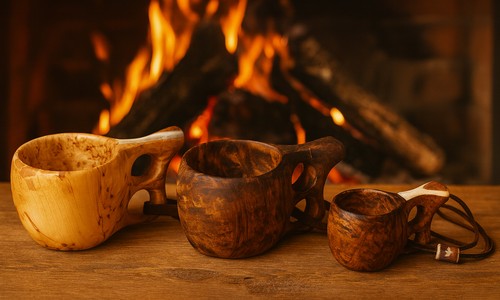
For Christmas, try to win one of our 3 favorite kuksa. A handmade wooden mug to celebrate the festive season. 🎄
To enter, add your email address below
Contest results on December 21. 🍀
